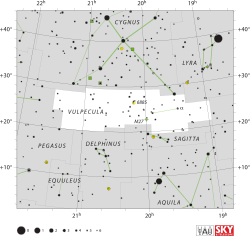Vulpecula
| Constellation | |

|
|
| Abbreviation | Vul |
|---|---|
| Genitive | Vulpeculae |
| Pronunciation |
/vʌlˈpɛkjʊlə/, genitive /vʌlˈpɛkjʊliː/ |
| Symbolism | the Fox |
| Right ascension | 20 |
| Declination | +25 |
| Quadrant | NQ4 |
| Area | 268 sq. deg. (55th) |
| Main stars | 5, 20 |
|
Bayer/Flamsteed stars |
33 |
| Stars with planets | 5 |
| Stars brighter than 3.00m | 0 |
| Stars within 10.00 pc (32.62 ly) | 0 |
| Brightest star | α Vul (Anser) (4.44m) |
| Nearest star |
Ross 165 (33.54 ly, 10.28 pc) |
| Messier objects | 1 |
| Bordering constellations |
Cygnus Lyra Hercules Sagitta Delphinus Pegasus |
|
Visible at latitudes between +90° and −55°. Best visible at 21:00 (9 p.m.) during the month of September. |
|
Vulpecula /vʌlˈpɛkjʊlə/ is a faint constellation in the northern sky. Its name is Latin for "little fox", although it is commonly known simply as the fox. It was identified in the seventeenth century, and is located in the middle of the Summer Triangle (an asterism consisting of the bright stars Deneb, Vega and Altair).
There are no stars brighter than 4th magnitude in this constellation. The brightest star in Vulpecula is Alpha Vulpeculae, a magnitude 4.44mred giant at a distance of 297 light-years. The star is an optical binary (separation of 413.7") that can be split using binoculars. The star also carries the traditional name Anser, which refers to the goose the little fox holds in its jaws.
23 Vulpeculae is the second brightest star in the constellation.
In 1967, the first pulsar, PSR B1919+21, was discovered in Vulpecula by Jocelyn Bell, supervised by Antony Hewish, in Cambridge. While they were searching for scintillation of radio signals of quasars, they observed pulses which repeated with a period of 1.3373 seconds. Terrestrial origin of the signal was ruled out because the time it took the object to reappear was a sidereal day instead of a solar day. This anomaly was finally identified as the signal of a rapidly rotating neutron star. Fifteen years after the first pulsar was discovered, the first millisecond pulsar, PSR B1937+21, was also discovered in Vulpecula, only a few degrees in the sky away from PSR B1919+21.
...
Wikipedia
